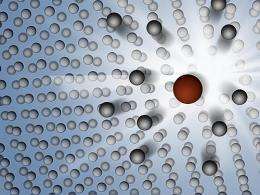Method that can validate nuclear collision models benefits IAEA

A novel technique for materials research is unexpectedly also contributing to the nuclear safety efforts of the International Atomic Energy Agency. Pacific Northwest National Laboratory scientist Dr. Weilin Jiang and his team developed a novel analytical method for measuring the concentration of oxygen atoms at different depths in solid samples. Because their data, published in 2003, can also be used to validate theoretical models that describe how likely nuclear reactions can occur, it caught the attention of the IAEA.
In addition to materials applications such as detecting metal corrosion and characterizing insulation layers used in electronic devices, the data can also be used to validate theoretical models of complex nuclear interactions. The research is also relevant to the structural materials used to build nuclear reactors, nuclear waste confinement facilities, and space vehicles. Nuclear processes can cause such materials to deteriorate over time, so assessing and predicting their performance is critical for safe and successful nuclear operations.
In 2011, the team's published data were included in IAEA's EXFOR database. EXFOR is an extensive, publicly available collection of experimental nuclear reaction data used by a broad cross section of the research community, from materials scientists to nuclear physicists.
Jiang is honored to contribute to EXFOR noting that, "The IAEA database is quite selective."
This research is helping the IAEA work for the safe, secure, and peaceful uses of nuclear science and technology.
Using EMSL accelerator capabilities and a silicon dioxide, SiO2, thin film as a standard, the researchers bombarded the SiO2 thin film with helium or deuterium ions traveling at different speeds and carrying different amounts of energy. Using a number of techniques and detectors, they detected the reaction products emitting from the thin film. The measured yield from the oxygen nuclear reaction is proportional to the probability at which the nuclear reaction occurs. An example was demonstrated for measuring the concentration of oxygen atoms at different depths in a solid sample. Oxygen diffusion in solid materials or at interfaces can be studied using the method.
This research is contributing to PNNL's ongoing materials science research. Oxide ceramic materials are analyzed at PNNL using the developed method. Efforts are focusing on nanocrystalline ceramic materials and single crystals that are resistant to nuclear irradiation.
More information: Jiang W, V Shutthanandan, S Thevuthasan, DE McCready, and WJ Weber. 2003. "Oxygen Analysis Using Energetic Ion Beams." Nuclear Instruments and Methods in Physics Research Section B: Beam Interactions with Materials and Atoms 207(4):453-461.
Provided by Pacific Northwest National Laboratory


















